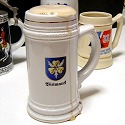
Report of the Commander in Chief, Navy, to the Führer on 29 April 1940 at 1530.
1. Further Construction on the Aircraft Carrier GRAF ZEPPELIN.
The Commander in Chief, Navy, proposes cessation of further construction work, since the ship will not be ready for commissioning until the end of 1940, and the artillery will not be installed for about another ten months (the anti-aircraft guns are now already being used elsewhere; fire control of naval artillery has been delayed by transactions with Russia, etc.).
Including the necessary trials, the carrier will therefore not be entirely ready before the end of 1941.
The Führer is of the opinion that, considering the probable developments in aircraft, carriers with planes with internal combustion engines will not be useable anymore in this war.
The artillery of the GRAF ZEPPELIN must be utilized for Norway to protect coastal waters (defense of fishing vessels and coastal traffic).
The guns of the two old coastal fortifications should also be used for this purpose.
The question as to whether 38 cm., and 40 cm. guns are necessary for the defense of Oslo is to be investigated.
2. The Führer requests that the EMDEN be left in Oslo for another two weeks for anti-aircraft defense of the harbor, which is quite inadequate.
The EMDEN will be unnecessary as soon as three heavy anti-aircraft batteries are available in Oslo harbor (to protect oil tanks).
The Commander in Chief, Navy, explains the reasons why the return of the EMDEN is at present desirable.
3. Troop Transports to Norway. The Commander in Chief, Navy, explains that the amount transported is not dependent on the number of vessels available, but on the number of escort forces, which are operating uninterruptedly and under greatest pressure.
Experience has shown that medium-sized, fast steamers are most suitable for transport purposes, also fast transport by means of torpedo boats, etc.
There were no losses recently.
The Führer is anxious for speedy transfer of the 2nd Mountain Division, which has been in progress since 29 April.
Question: Can a large part of this division be transported by the POTSDAM and GNEISENAU?
Answer: Each ship can take care of about 5,000 men with limited equipment (no horses).
However, there is the danger that large ships are more likely to be sunk by submarines and that a great number of soldiers might thus be lost.
In addition a large number of fast escort forces would be needed, which would then not be available for other transports.
The question will be investigated as to when and where these two vessels could be ready and what equipment they could carry - whether, therefore, the transfer of the Mountain Division would actually be accelerated.
|
 BOOK: The Battleship Bismarck. The Complete History of the Ship.
 Naval & military gifts
|
